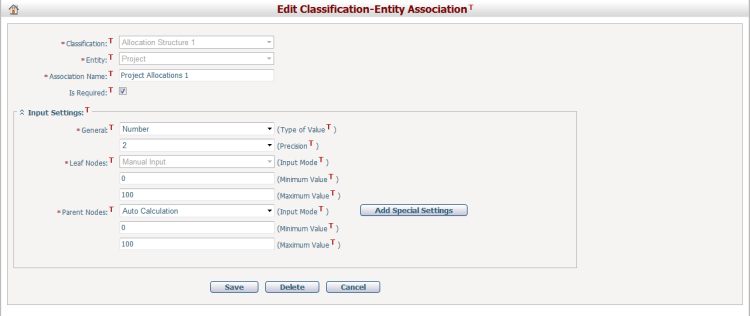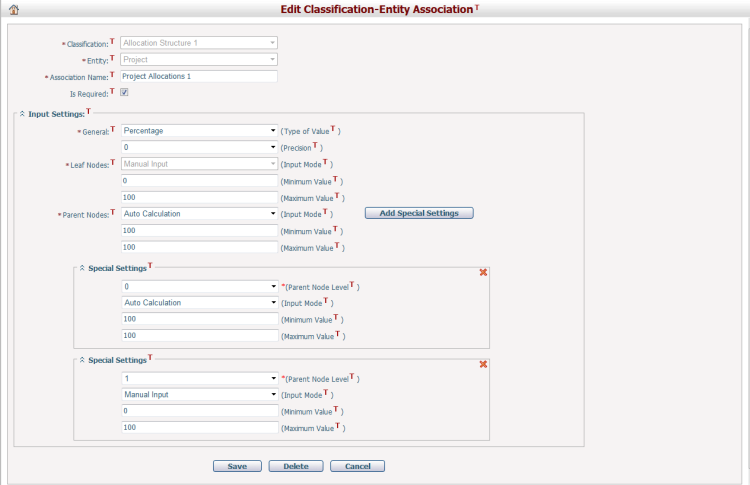Navigate Here: Utilities > Classifications > Classification-Entity Associations > click the Edit icon
You can edit an existing classification-entity association on the Edit Classification-Entity Association page.


To edit a classification-entity association, you can update following fields:
The required fields are noted with an asterisk (*).
Association Name*: enter a unique name for the association
Is Required: check this option if you want to make the corresponding field on entity form required (i.e. values must be provided for at least one node of the classification)
Input Settings: multiple setting fields are included in this field set.
General*: select Type of Value and Precision
Type of Value: it includes two options "Number" and "Percentage". The difference between these two options are that, a symbol "%" will be added to the right of the entered node value on entity form if "Percentage" is selected.
Precision: it defines the precision of the entered node values and includes five options "0" through "4".
Leaf Nodes*: enter the allowed Minimum Value and Maximum Value for all leaf nodes of the classification (Leaf Node refers to a node that has no child node in the classification)
Input Mode: the input mode for leaf nodes is always "Manual Input" and cannot be changed.
Minimum Value: it defines the minimum number that can be entered for leaf nodes.
Maximum Value: it defines the maximum number that can be entered for leaf nodes.
Parent Nodes*: select Input Mode and enter the allowed Minimum Value and Maximum Value for parent nodes at all levels (Parent Node refers to a node that has at least one child node in the classification)
Input Mode: it includes two options "Manual Input" and "Auto Calculation", and defines whether the node value is manually inputted or automatically calculated by summing up values of its child nodes.
Minimum Value: it defines the minimum number that can be entered for parent nodes.
Maximum Value: it defines the maximum number that can be entered for parent nodes.
If you don't want to apply the same settings to parent nodes at all levels (i.e. you want to apply special settings to parent nodes at certain levels), you can click the Add Special Settings button, and a field set named "Special Settings" will be added below. (Notes: Every time you click on this button, a Special Settings field set will be added below. You can click on the Remove icon ![]() to remove the Special Settings field set.)
to remove the Special Settings field set.)
Parent Node Level*: it specifies for parent nodes at which level you want to add the special settings. It has nine options "0" through "8".
Parent nodes at Level 1 refer to root nodes of the classification that have at least one child node, parent nodes at Level 2 refer to child nodes of parent nodes at Level 1 that have at least one child node, parent nodes at Level 3 refer to child nodes of parent nodes at Level 2 that have at least one child node, and so forth.
Note that, parent nodes at Level 0 don't really exist in a classification. The option "0" is used to set restrictions for parent nodes at Level 1.
Input Mode: it includes two options "Manual Input" and "Auto Calculation", and defines whether the node value is manually inputted or automatically calculated by summing up values of its child nodes.
Note that, if Parent Node Level is "0", the Input Mode must be "Auto Calculation". It won't take effect if "Manual Input" is selected, because parent nodes at Level 0 don't really exist in a classification and we cannot enter values for them.
Minimum Value: it defines the minimum number that can be entered for parent nodes.
Maximum Value: it defines the maximum number that can be entered for parent nodes.
After you have completed necessary modifications for the to-be-added classification-entity association, you can:
Click on Save button to save changes to the current classification-entity association and return to Browse Classification-Entity Associations page.
Click on Cancel button to abort updating the current classification-entity association and directly return to Browse Classification-Entity Associations page.
You can also click on Delete button to delete the current classification-entity association. (If the current classification-entity association has been added to the entity form as a special custom field, it cannot be deleted.) Browse Classification-Entity Associations page will be returned if the current classification-entity association is successfully deleted.